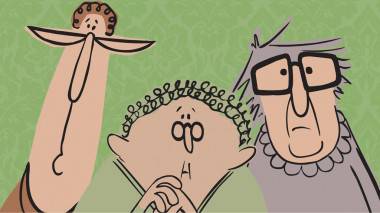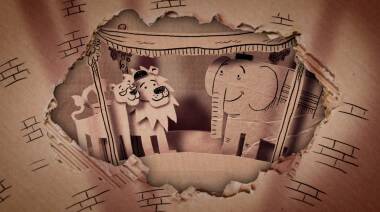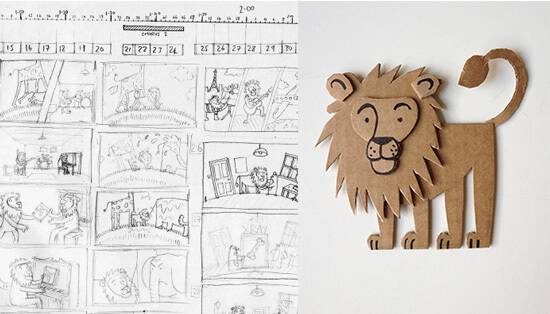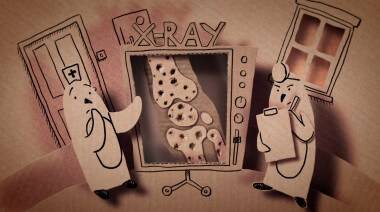The Lion: Interview with Director Peter Baynton
From a complete career change to working for his favourite studio, director and animator, Peter Baynton has had a varied and rewarding career so far. With a great selection of films and awards to his name and now his very own studios, Radish Pictures, he reveals all about his latest triumph, The Lion. Which has already won the Special Jury Award at Annecy this year.
As a director you have created some very memorable films such as Save Our Bacon and Over the Hill. How did you first start out in the world of animation and is storytelling something that you’ve always had a passion for?
For me nothing beats a good story, with the possible exception of a good picture. And a picture that tells a good story tops the lot. When I was young I loved Asterix, Swallows and Amazons, James Bond and Nancy Drew (worryingly enough) and then in my teens I spent a lot of time admiring the work of painters like Stanley Spencer and Paula Rego, whose images are brimming with story and character. So yes, I think storytelling is definitely something I’ve always had a passion for, and particularly the opportunity to combine story-telling and illustration.
I very nearly became an architect before finding animation. I did a degree in architecture but I found that I was much more excited about the drawings of buildings than the actual buildings themselves. (Using different ways of drawing space – axonometrics, elevations, perspectives – is a bit like storyboarding – you’ve got to pick the right angle to tell the story the way you want.) Then one day I went to an animation screening at a London film festival and saw a mesmerising bunch of films. The one that sticks firmly in my memory is Mark Baker’s Jolly Roger, and it left me thinking: I want to do that. I went and did a short-course whilst working for an architecture practice, and from there spent a year at St Martin’s studying for a diploma in character animation.
Wow, that is quite a career change, at want point was it that Tandem Films picked you up and how did that feel to work for such a great and pioneering studio?
Tandem was the studio I was idolising whilst I was studying. Dan Greaves is a creative genius, always pushing to find novel ways of animating things, and never compromising on really solid, funny character animation and storytelling. So when they asked me onboard, after I’d sent them Over The Hill and done a couple of freelance jobs there, I couldn’t have been happier or more excited. Or more terrified, of course.
Most recently you have won the Special Jury Award at Annecy this year for your film The Lion. Does it feel extra special winning under the banner of your new studio, Radish Pictures.
It certainly does! I’ve had several happy years directing at Tandem Films working with a very talented group of people, as well as making things independently. Having the chance to run my own studio, though, is something I’ve wanted to do for a while. To have had some success with it already is very gratifying and affirming, and it spurs me on creatively to have a good stab at the next thing.
How did the film come about, were you approached by the artist of the song, Benjamin Scheuer?
Benjamin sent me a copy of his song to see if I had any ideas for an animated video for it. It was one of those moments where I knew instantly that it was something I wanted to do, simply because the song was so beautiful, and the lyrics cried out to be animated. The song weaves an detailed story, including four generations of a family within the first verse (and three within the first two lines), so I wanted to find a way to nimbly skip back and forth through time without simply cutting. This is where the big spinning wheel idea came from. There’s also something about the song that’s redolent of a nursery rhyme or children’s poem, so this gave me the idea of setting the video in a miniature toy theatre. Those two ideas were the creative drivers for the piece.
Obviously the inspiration for the film came from the lyrics, did you find it challenging in trying to communicate the sometimes quite saddening moments?
I actually found the sad bits the easiest to communicate, because you can keep the animation very simple and allow the moment to speak for itself. Putting an unhappy lion in a hospital bed and announcing he has cancer doesn’t need a great deal of work. It was the less dramatic moments, like during the second verse, that required a lot more consideration. Also whereas the verses are literal, the choruses are more figurative, so finding a motif to use there took more thought. In the end we opted for something quite simple: the idea of running through the savannah, accumulating friends along the way, felt like a positive metaphor for life.
The imagery of all the animals joining him is defiantly something that will stick in viewers thoughts. How did the character designs come about and was a more cartoony approach intentional to soften the mood?
I wanted the character designs to be as simple as possible, to keep the piece feeling child-like and innocent, and yes, to highlight the positivity of the song instead of the more sombre moments. Simple characters I think are naturally a bit cuter, especially when you shove a smile on them, but also it made it easier to animate!
Did Benjamin have a lot of say in the creative process, or did he trust you to get on with it?
Benjamin was the ideal collaborator: he had a clear idea of what he was looking in terms of its feel, but was completely open to me coming up with a visual style. He didn’t appear worried by the extremely sketchy thumbnail storyboard I used to explain my ideas, and he was astute and considered in all his feedback. During production he stood back and let us get on with it, but also came up with some great ideas of his own, and we were all very pleased with the final result.
The film is composited very well to look like a stop motion animation. Was that a conscious choice to do it all in the computer instead of actual stop motion?
Yes. Initially I fantasised about building it all and shooting it in stop motion, but it quite quickly became clear that the budget wouldn’t allow us to do what we wanted to do in stop motion. So we decided to try and find a way to realise the creative vision without physically making the set. Trying to re-create the lighting and feel of a toy theatre was a useful creative tether to keep us focussed, and a fun challenge. We had on board a super-talented compositor, Russell Etheridge, who did a brilliant job on the lighting and shadows.
What was your process in creating the animation, were there any happy accidents that made it into the final film?
All the artwork was made roughly in photoshop, with place-holders for the character animation, and then shoved into After Effects and animated. This established a skeleton for the video, and then we worked our way through and replaced the rough photoshop artwork with cardboard. The characters were animated in Flash and composited in AE with the backgrounds. Then once all the finished artwork was in AE and animating how we wanted it to, Russ painstakingly built the shadows for each layer. Finally we adjusted the lighting for each scene.
I made most of the video in New York and several times found myself rooting round dustbins and picking up scraps of card off the street when I spotted pieces with interesting tears or marks in it. Several bits found their way into the film and act like little memory joggers for me. The rhino’s back is one of them.
Cardboard features predominantly within The Lion, what was the artistic direction behind this?
There were several creative drivers behind using cardboard. It worked with the toy theatre concept, feeling suitably lo-fi and homemade, but also being of a recognisable scale: the little stripes that the internal corrugations leave on the surface tell us how big (or in this case small) the set is.
I knew that to animate a visually striking 3 minute video was going to take a lot of work, so I wanted to limit how much labour would be required for certain parts of the process. Using cardboard, which has its own texture and colour and in my opinion has a lovely aesthetic just left untouched, meant that colour didn’t have to be a part of the design process. It also meant that the character designs could be quite simple yet still feel rich. I guess most of all it felt right for the project – the song deals with the fragility of life, and cardboard is so cheap and disposable that it seemed a suitable choice.
You are a relatively young director with all your films winning awards, do you feel any pressure when you release something that it is now expected to be a success?
A bit of self-pressure, yes, mostly after my film Over The Hill actually, as it was the first thing I’d done after college and it won a bunch of awards. It leaves with you the difficult second album complex, especially if you’re naturally a bit of a crowd-pleaser. But you have to forget it and just pursue your own creative goals, otherwise you go crackers and end up not making anything at all.

The Lion seems to be going from strength to strength joining your already glowing reputation, what do you see next for Radish Pictures?
Well, we’re working on a few fairly diverse projects – a marketing video for the Welsh School of Architecture, an interactive children’s book, a piece for an exciting new art world venture, amongst other things. Then to make the next film
One last question, I have to ask, who’s job was it to cut out all the cardboard props, etc. Surely they deserve a special creative award?
There was actually much less cardboard cutting than you might think. As a shameless time-saving measure, several choice bits of artwork were cut out from cardboard, and then lots of others were cutout digitally, which as you can imagine is way easier on the index finger.
A big thanks to Peter Baynton for letting us into the world of The Lion and his new studios, Radish Pictures. I’m sure we’ll be in for a treat with all his new ventures. Looking forward to seeing more soon.




